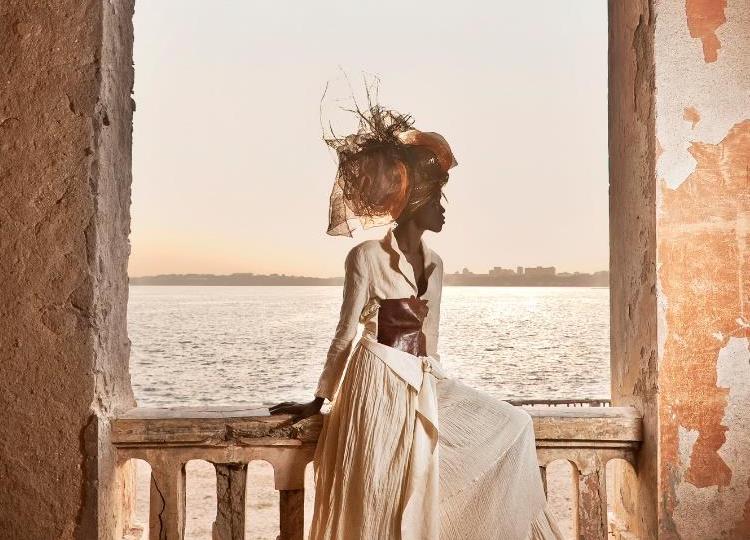Magnin-A, Paris, France
28 May 2021 - 31 Jul 2021

Fabrice Monteiro Signares #7 (detail), Gorée, 2011 © Fabrice Monteiro, ADAGP Courtesy Galerie MAGNIN-A
La galerie Magnin-A consacre ses deux espaces d’exposition aux femmes et à la photographie. Alors que le rez-de-chaussée dévoilera Les Drôlesses* d’agnès b. le second espace sera quant à lui dédié à la beauté envoutante et au pouvoir des Signares de Fabrice Monteiro.
Au Sénégal, l’émancipation des femmes, le prestige et la richesse se mesurent à la parure. Des coiffures travaillées aux foulards chatoyants et des vêtements sophistiqués, jusqu’aux souliers brodés et le tintement de l’or des bracelets, les femmes sénégalaises utilisent la mode à des fins sociopolitiques et économiques, ainsi que pour célébrer leur propre histoire. Voici tout le propos de la série Signares de Fabrice Monteiro.
Les signares (du portugais senhoras) étaient les jeunes femmes noires ou métisses, de la Petite-Côte du Sénégal, dans les comptoirs de Rufisque (Rufisco) au XVIIe siècle, puis de Gorée et de Saint-Louis jusqu’au milieu du XIXe siècle. Cette francisation du mot portugais senhora (dame) désigne à l’origine les femmes africaines qui, vivant en concubinage avec des Européens influents, acquièrent un rôle économique et un rang social élevé. Les signares semblent avoir existé depuis la fin du XVe siècle dans les comptoirs portugais sur toute la côte occidentale entre le Sénégal et le cap des Palmes. Cette appellation s’applique ensuite à toute femme retirant une certaine notoriété soit de son métissage, soit de son habileté de commerçante, souvent des deux à la fois.
Les signares réussirent au cours de différentes périodes d’occupation à résister aux gouverneurs et officiers qui contestaient régulièrement leur pouvoir et leurs privilèges. Ces femmes étaient réputées pour leur beauté envoûtante et leurs richesses, qu’elles firent fructifier habilement au cours du temps. Entre coquetterie quotidienne et fêtes dominicales, elles menèrent des vies d’indépendance loin de la domination patriarcale. Encore aujourd’hui, les descendantes des signares exercent un fort pouvoir d’influence au sein de la société.
Fabrice Monteiro est un Agouda, descendant des esclaves brésiliens portant des noms portugais. Fils d’un père béninois et d’une mère belge, il a grandi au Bénin. Après des études d’ingénierie industrielle, il débute une carrière internationale de mannequin, voyageant à travers le monde et découvrant le medium photographique. En 2007 il rencontre le photographe new-yorkais Alfonse Pagano et développe ses compétences de studio photo. Passé derrière la caméra, les photos de Fabrice Monteiro se situent à l’intersection du photojournalisme, de la photographie de mode et du tableau vivant.
« La mixité de mes cultures d’origine est ma première source d’inspiration. Les relations entre Afrique et Europe n’ont cessé d’osciller entre attirance et rejet, responsabilisation et déni, reconnaissance et colère. Jamais elles n’ont été indifférentes. . L’histoire des peuples afro-européens de ces derniers siècles, dont j’ai hérité la complexité jusque dans mes gènes, oriente tous mes choix artistiques et me donne le regard singulier du vécu. »
Il fait du portrait son support de prédilection et aborde, dans chacune de ses séries, une problématique forte liée au continent Africain qu’il aborde à travers le prisme de l’identité. Son dernier travail « 8 Mile Wall » explore les stéréotypes qui se sont construits pendant la période de l’esclavage et l’époque coloniale. La série est inspirée d’une conversation qu’il a eu, enfant, avec son père, lorsqu’il se rendit compte que, en tant qu’homme noir, la seule façon d’être traité avec égards et considération en Europe à l’époque était de porter un costume trois-pièces. Il déconstruit ces automatismes de pensées créées par des détails esthétiques, qu’ils soient costumes ou accessoires.